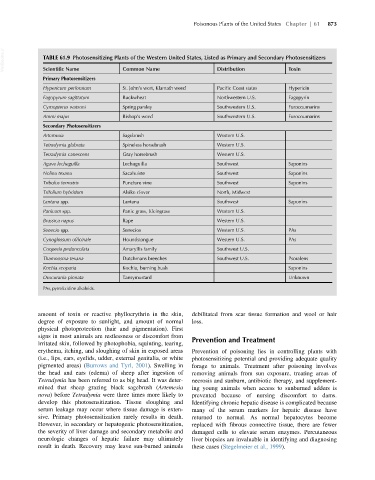Page 918 - Veterinary Toxicology, Basic and Clinical Principles, 3rd Edition
P. 918
Poisonous Plants of the United States Chapter | 61 873
VetBooks.ir TABLE 61.9 Photosensitizing Plants of the Western United States, Listed as Primary and Secondary Photosensitizers
Common Name
Scientific Name
Toxin
Distribution
Primary Photosensitizers
Hypericum perforatum St. John’s wort, Klamath weed Pacific Coast states Hypericin
Fagopyrum sagittatum Buckwheat Northwestern U.S. Fagopyrin
Cymopterus watsoni Spring parsley Southwestern U.S. Furocoumarins
Ammi majus Bishop’s weed Southwestern U.S. Furocoumarins
Secondary Photosensitizers
Artemesia Sagebrush Western U.S.
Tetradymia glabrata Spineless horsebrush Western U.S.
Tetradymia canescens Gray horsebrush Western U.S.
Agave lecheguilla Lechuguilla Southwest Saponins
Nolina texana Sacahuiste Southwest Saponins
Tribulus terrestris Puncture vine Southwest Saponins
Trifolium hybridum Alsike clover North, Midwest
Lantana spp. Lantana Southwest Saponins
Panicum spp. Panic grass, Kleingrass Western U.S.
Brassica napus Rape Western U.S.
Senecio spp. Senecios Western U.S. PAs
Cynoglossum officinale Houndstongue Western U.S. PAs
Cooperia pedunculata Amaryllis family Southwest U.S.
Thamnosma texana Dutchmans breeches Southwest U.S. Psoralens
Kochia scoparia Kochia, burning bush Saponins
Descurania pinnata Tansymustard Unknown
PAs, pyrrolizidine alkaloids.
amount of toxin or reactive phylloerythrin in the skin, debilitated from scar tissue formation and wool or hair
degree of exposure to sunlight, and amount of normal loss.
physical photoprotection (hair and pigmentation). First
signs in most animals are restlessness or discomfort from Prevention and Treatment
irritated skin, followed by photophobia, squinting, tearing,
erythema, itching, and sloughing of skin in exposed areas Prevention of poisoning lies in controlling plants with
(i.e., lips, ears, eyelids, udder, external genitalia, or white photosensitizing potential and providing adequate quality
pigmented areas) (Burrows and Tyrl, 2001). Swelling in forage to animals. Treatment after poisoning involves
the head and ears (edema) of sheep after ingestion of removing animals from sun exposure, treating areas of
Tetradymia has been referred to as big head. It was deter- necrosis and sunburn, antibiotic therapy, and supplement-
mined that sheep grazing black sagebrush (Artemesia ing young animals when access to sunburned udders is
nova) before Tetradymia were three times more likely to prevented because of nursing discomfort to dams.
develop this photosensitization. Tissue sloughing and Identifying chronic hepatic disease is complicated because
serum leakage may occur where tissue damage is exten- many of the serum markers for hepatic disease have
sive. Primary photosensitization rarely results in death. returned to normal. As normal hepatocytes become
However, in secondary or hepatogenic photosensitization, replaced with fibrous connective tissue, there are fewer
the severity of liver damage and secondary metabolic and damaged cells to elevate serum enzymes. Percutaneous
neurologic changes of hepatic failure may ultimately liver biopsies are invaluable in identifying and diagnosing
result in death. Recovery may leave sun-burned animals these cases (Stegelmeier et al., 1999).

